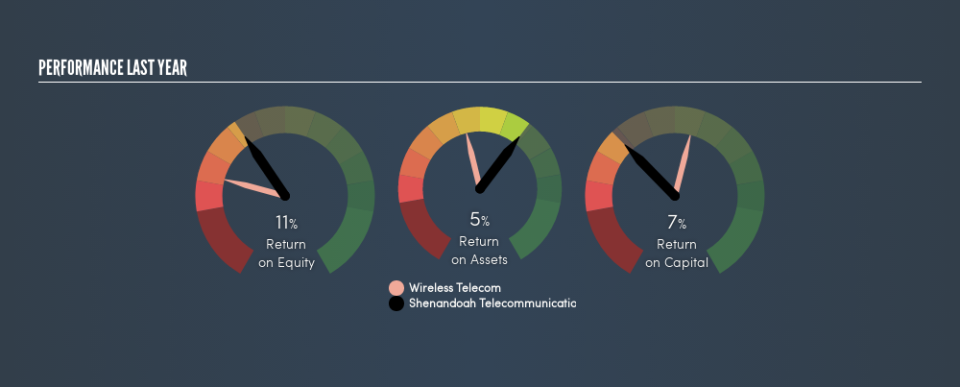Is Shenandoah Telecommunications Company’s (NASDAQ:SHEN) Capital Allocation Ability Worth Your Time?

Today we are going to look at Shenandoah Telecommunications Company (NASDAQ:SHEN) to see whether it might be an attractive investment prospect. Specifically, we’ll consider its Return On Capital Employed (ROCE), since that will give us an insight into how efficiently the business can generate profits from the capital it requires.
First, we’ll go over how we calculate ROCE. Next, we’ll compare it to others in its industry. Then we’ll determine how its current liabilities are affecting its ROCE.
Return On Capital Employed (ROCE): What is it?
ROCE measures the ‘return’ (pre-tax profit) a company generates from capital employed in its business. Generally speaking a higher ROCE is better. In brief, it is a useful tool, but it is not without drawbacks. Author Edwin Whiting says to be careful when comparing the ROCE of different businesses, since ‘No two businesses are exactly alike.’
So, How Do We Calculate ROCE?
The formula for calculating the return on capital employed is:
Return on Capital Employed = Earnings Before Interest and Tax (EBIT) ÷ (Total Assets – Current Liabilities)
Or for Shenandoah Telecommunications:
0.067 = US$93m ÷ (US$1.5b – US$89m) (Based on the trailing twelve months to December 2018.)
So, Shenandoah Telecommunications has an ROCE of 6.7%.
Check out our latest analysis for Shenandoah Telecommunications
Want to participate in a research study? Help shape the future of investing tools and earn a $60 gift card!
Does Shenandoah Telecommunications Have A Good ROCE?
When making comparisons between similar businesses, investors may find ROCE useful. Using our data, Shenandoah Telecommunications’s ROCE appears to be around the 6.3% average of the Wireless Telecom industry. Separate from how Shenandoah Telecommunications stacks up against its industry, its ROCE in absolute terms is mediocre; relative to the returns on government bonds. Investors may wish to consider higher-performing investments.
Shenandoah Telecommunications’s current ROCE of 6.7% is lower than its ROCE in the past, which was 14%, 3 years ago. Therefore we wonder if the company is facing new headwinds.
It is important to remember that ROCE shows past performance, and is not necessarily predictive. Companies in cyclical industries can be difficult to understand using ROCE, as returns typically look high during boom times, and low during busts. This is because ROCE only looks at one year, instead of considering returns across a whole cycle. Future performance is what matters, and you can see analyst predictions in our free report on analyst forecasts for the company.
Shenandoah Telecommunications’s Current Liabilities And Their Impact On Its ROCE
Short term (or current) liabilities, are things like supplier invoices, overdrafts, or tax bills that need to be paid within 12 months. Due to the way the ROCE equation works, having large bills due in the near term can make it look as though a company has less capital employed, and thus a higher ROCE than usual. To counter this, investors can check if a company has high current liabilities relative to total assets.
Shenandoah Telecommunications has total assets of US$1.5b and current liabilities of US$89m. Therefore its current liabilities are equivalent to approximately 6.0% of its total assets. Shenandoah Telecommunications has a low level of current liabilities, which have a minimal impact on its uninspiring ROCE.
The Bottom Line On Shenandoah Telecommunications’s ROCE
Based on this information, Shenandoah Telecommunications appears to be a mediocre business. But note: Shenandoah Telecommunications may not be the best stock to buy. So take a peek at this free list of interesting companies with strong recent earnings growth (and a P/E ratio below 20).
If you like to buy stocks alongside management, then you might just love this free list of companies. (Hint: insiders have been buying them).
We aim to bring you long-term focused research analysis driven by fundamental data. Note that our analysis may not factor in the latest price-sensitive company announcements or qualitative material.
If you spot an error that warrants correction, please contact the editor at editorial-team@simplywallst.com. This article by Simply Wall St is general in nature. It does not constitute a recommendation to buy or sell any stock, and does not take account of your objectives, or your financial situation. Simply Wall St has no position in the stocks mentioned. Thank you for reading.

